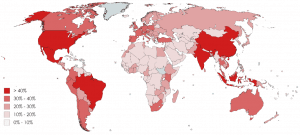In September 2015, the United Nations Member States adopted the 2030 Agenda for Sustainable Development which comprised a new set of Sustainable Development Goals (SDGs). Market-based tools like Voluntary sustainability standards (VSS) are expected to play an increasingly important role in complementing governments’ efforts towards achieving these goals. In essence, VSS aim to foster more sustainable and transparent practices among actors at all levels of global value chains, hence contributing largely to achieving SDG 12 on sustainable consumption and production among other SDGs.
However, the recent COVID-19 has slowed down economic growth, increased unemployment, and even raised poverty and global hunger, rolling back the decade long progress to achieve the SDGs. One crucial issue the pandemic highlighted is the vulnerability of societies to risks affecting the health of people. Other health concerns are associated with how we produce, consume and trade products, and to the social and environmental consequences of these activities. Thus, it is even more important now to put the SDGs at the heart of policy making.
VSS have been recognized as potentially transformative tools for governments to realize their sustainability commitment.
The recent launch of the 4th United Nations Forum on Sustainability Standards (UNFSS)[1] Flagship report on ‘Upscaling VSS through Sustainable Public Procurement and Trade Policy‘, provides policy making scenarios to expand and rethink socioeconomic models that do not compromise the three pillars of sustainable development and complement the widely emphasized need for improvements in public health systems. The integration of VSS in public procurement and trade policies are potentially powerful means to upscale the adoption of VSS.
The report focuses on the adoption of VSS by refering to the degree of its uptake by producers or firms along the global value chains. This can be measured by different indicators, such as the total number of VSS schemes that are active globally or in selected countries, the number of producers or firms that are certified, the number of certified hectares of production land, and the proportion of certified products per commodity.
“It’s entirely a question of political will. The change in consumption patterns that some countries have been able to put in place in the face of the Covid crisis should give us courage that such a transition is indeed possible. Covid in this sense is a rehearsal for the kind of collective action needed globally to meet the existential challenge of environmental degradation due to climate change.” UNCTAD Secretary-General, Mukhisa Kituyi answers questions on how lessons from the fight to curb the pandemic could help speed up progress towards the Sustainable Development Goals.
VSS adoption trends and dynamics
Sustainability is not a new phenomenon. It appeared for the first time in 1987 in the famous Brundtland Report (also known as ´Our Common Future´) produced by several countries for the UN. The trend for sustainability standards picked up further thereafter with the introduction of the Dutch Fair Trade standard, Ecolabels and standards for organic food and products.
Today, there are over 400 of such standards. Figure 1 shows the number of VSS in operation captured by the ITC Standards Map and Ecolabel Index.
The Flagship report identifies two trends. First, although the idea behind VSS is quite old, their proliferation is more recent: VSS truly emerged in the 1990s, and their number grew consistently until the early 2010s. Second, growth in the number of active VSS has been slowing down in recent years , though it is unclear why this has happened.
Figure 1: Evolution in the number of VSS active worldwide, 1940–2020

Source: Authors’ calculations based on ITC Standards Map[2] and Ecolabel Index.[3]
These VSS are, to different degrees, active in countries across the world. The Map below shows the degree of adoption by country measured as the percentage of active VSS in a specific country in relation to the total number of active VSS worldwide.
Map 1: VSS adoption intensity map per country (as a percentage of all VSS)

Source: Authors’ map based on ITC Standards Map[4]
Several observations can be made:
– VSS are found in all countries, but there is considerable variation between countries.
-Variation in adoption levels appears to more or less align with income levels.
-While variation in adoption levels does not always perfectly align with income level, there is also variation between similar countries in relation to VSS activity.
-Some lower-middle-income countries score high, such as Viet Nam, Indonesia and India.
-Even some low-income countries score fairly high, such as the United Republic of Tanzania and Ethiopia.
Making headway to upscale VSS adoption
Concerning the evolution of certified commodities, the Flagship report shows that certification has intensified over the past decade, in terms of both the proportion of certified commodities in their respective markets and the proportion of certified production area.
However, publications also indicate that while certification is gaining grounds, overall, only a limited amount of land is certified. For example, often less than 5% of agricultural land of some commodities are certified.
These trends indicate that there is still quite some scope for increasing adoption of, or upscaling, VSS. An important actor in upscaling VSS are governments.
It is also worth noting that integrating sustainable development in public procurement and trade policy is easier said than done. The analyses from the report show that, not only is VSS adoption more feasible for open economies with diversified economic sectors such as those that belong in the large developed and middle-income countries with relatively well-functioning government systems, but that the challenge also lies with capacity issues of VSS to deal with increased global demand.
Moreover, there is also a possible distributional effect of upscaling VSS related to the “stuck to the bottom” problem, whereby some producers are excluded from the VSS dynamics – and therefore from high-quality markets – as they cannot afford high certification costs, which could constitute a significant barrier to their adoption of VSS. This is especially evident in the low-income and least developed countries.
Our next blog discusses how governments can upscale VSS.
ENDNOTES
[1] UNFSS is an initiative of five United Nations agencies, the United Nations Conference on Trade and Development (UNCTAD) the Food and Agriculture Organization (FAO), the International Trade Centre (ITC), the United Nations Environment Programme (UNEP), and the United Nations Industrial Development Organization (UNIDO). UNCTAD is the secretariat of UNFSS.
[2] ITC (n.d.). ITC Standards Map. Available at: https://sustainabilitymap.org/standards?q=eyJzZWxlY3RlZENsaWVudCI6Ik5PIEFGRklMSUFUSU9OIn0%3D (accessed, March 2020).
[3] Ecolabel Index (n.d.). Ecolabel Index. Available at: http://www.ecolabelindex.com/ecolabels/ (accessed, March 2020).
[4] ITC (n.d.). ITC Standards Map. Available at: https://sustainabilitymap.org/standards?q=eyJzZWxlY3RlZENsaWVudCI6Ik5PIEFGRklMSUFUSU9OIn0%3D (accessed, March 2020).

